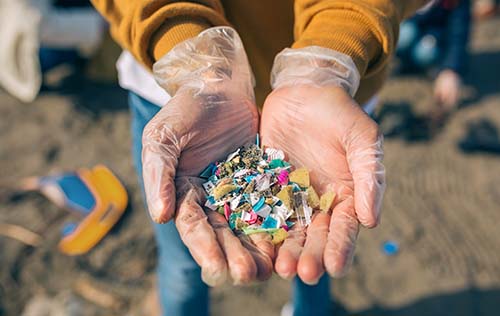Decrease Single Use Plastics and Decrease Disease
By Dr. Edwin Chun

By now you are probably familiar with the problematic issues of single-use plastics. They have been in the news for some time now. Single-use plastics include items like straws, plastic bags, food wrappers, and fast food containers, plastic forks, knives, cups, coffee stirrers etc. These items are designed for convenience and meant to be thrown away after one use.
The truth is that they are too convenient so that as a society, we have become lazy and created so much of it, that it has become a serious problem trying to get rid of it. Estimates of the effects of not only single-use plastics but all plastics on the environment is staggering. Of all the global plastic created by man since its inception, most of it is still creeping around in the environment and has not broken down or truly been recycled, which is what most of us are led to believe.
Mounds of plastic trash is being hidden away in landfills or floating around in oceans, lakes and waterways. After many years, much of it in the environment is gradually being broken down into what is known as microplastics which are tiny little pieces of plastic, some too small to even be seen with the naked eye. Microplastics are being ingested in the human diet and the diets of animals as they commonly find their way into ocean marine life and other animals like birds, which mistakenly eat it thinking it is plant life. Humans then turn around and eat some of these fish and get them into their bodies.
Some estimates indicate that there are microplastics in the majority of fish living in the major lakes of our country. This means that it can be very easy for these things to make it back into human life and start to effect human health negatively as plastics are associated with diseases like cancer, hormone abnormalities, endocrine disruption and more. A great recent documentary to learn more about this global epidemic is the Plastic Problem on public broadcasting: https://www.pbs.org/video/the-plastic-problem-7kdvzo/
The problem if left unchecked will become an overwhelming burden for society. It has already taken its toll on animals like whales, turtles, and birds. Many great whales are found dead with clogged digestion due to plastic consumption. It is important to be aware of the painful truths behind the scenes.
Many people are led to believe that recycling will take care of all these problems and that they will not become an issue. However, anybody who studies the data will clearly see that recycling is barely touching the surface of what to do with plastic waste. It is merely a façade meant to make consumers think they are being responsible when throwing them away so they can continue to buy the next plastic item and repeat the cycle.
The good news is that many great nations and businesses are getting on board and decreasing, banning, and/or limiting single-use plastics which is a good start. Becoming wise enough to understand this issue and caring enough to decrease unnecessary use of single-use plastics can make a difference for a better brighter future for us all.
Life is hard and there are situations when you need to use a single-use plastic items and that should be ok, but there are many times you don’t really need to, and that’s where you can make a difference with some preparation and planning. The important thing is being aware of this global crisis and not being brainwashed into using single-use plastics all the time.
Here are 22 Preposterous Facts About Plastic Pollution:
(Taken from ECOWATCH by N. D’ Alessandro 2014)
- In the Los Angeles area alone, 10 metric tons of plastic fragments—like grocery bags, straws and soda bottles—are carried into the Pacific Ocean every day.
- Over the last ten years we have produced more plastic than during the whole of the last century.
- 50 percent of the plastic we use, we use just once and throw away.
- Enough plastic is thrown away each year to circle the earth four times.
- We currently recover only five percent of the plastics we produce.
- The average American throws away approximately 185 pounds of plastic per year.
- Plastic accounts for around 10 percent of the total waste we generate.
- The production of plastic uses around eight percent of the world's oil production (bioplastics are not a good solution as they require food source crops).
- Americans throw away 35 billion plastic water bottles every year (source: Brita)
- Plastic in the ocean breaks down into such small segments that pieces of plastic from a one liter bottle could end up on every mile of beach throughout the world.
- Annually approximately 500 billion plastic bags are used worldwide. More than one million bags are used every minute.
- 46 percent of plastics float (EPA 2006) and it can drift for years before eventually concentrating in the ocean gyres.
- It takes 500-1,000 years for plastic to degrade.
- Billions of pounds of plastic can be found in swirling convergences in the oceans making up about 40 percent of the world's ocean surfaces. 80 percent of pollution enters the ocean from the land.
- The Great Pacific Garbage Patch is located in the North Pacific Gyre off the coast of California and is the largest ocean garbage site in the world. This floating mass of plastic is twice the size of Texas, with plastic pieces outnumbering sea life six to one.
- Plastic constitutes approximately 90 percent of all trash floating on the ocean's surface, with 46,000 pieces of plastic per square mile.
- One million sea birds and 100,000 marine mammals are killed annually from plastic in our oceans.
- 44 percent of all seabird species, 22 percent of cetaceans, all sea turtle species and a growing list of fish species have been documented with plastic in or around their bodies.
- In samples collected in Lake Erie, 85 percent of the plastic particles were smaller than two-tenths of an inch, and much of that was microscopic. Researchers found 1,500 and 1.7 million of these particles per square mile.
- Virtually every piece of plastic that was ever made still exists in some shape or form (with the exception of the small amount that has been incinerated).
- Plastic chemicals can be absorbed by the body—93 percent of Americans age six or older test positive for BPA (a plastic chemical).
- Some of these compounds found in plastic have been found to alter hormones or have other potential human health effects.
Here are 10 Ways to Rise Above Plastic:
- Choose to reuse when it comes to shopping bags and bottled water. Cloth bags and metal or glass reusable bottles are available locally at great prices.
- Refuse single-serving packaging, excess packaging, straws and other "disposable" plastics. Carry reusable utensils in your purse, backpack or car to use at bbq's, potlucks or take-out restaurants.
- Reduce everyday plastics such as sandwich bags and juice cartons by replacing them with a reusable lunch bag/box that includes a thermos.
- Bring your to-go mug with you to the coffee shop, smoothie shop or restaurants that let you use them, which is a great way to reduce lids, plastic cups and/or plastic-lined cups.
- Go digital! No need for plastic CDs, DVDs and jewel cases when you can buy your music and videos online.
- Seek out alternatives to the plastic items that you rely on.
- Recycle. If you must use plastic, try to choose #1 (PETE) or #2 (HDPE), which are the most commonly recycled plastics. Avoid plastic bags and polystyrene foam as both typically have very low recycling rates.
- Volunteer at a beach cleanup. Surfrider Foundation Chapters often hold cleanups monthly or more frequently.
- Support plastic bag bans, polystyrene foam bans and bottle recycling bills.
- Spread the word. Talk to your family and friends about why it is important to reduce plastic in our lives and the nasty impacts of plastic pollution.
